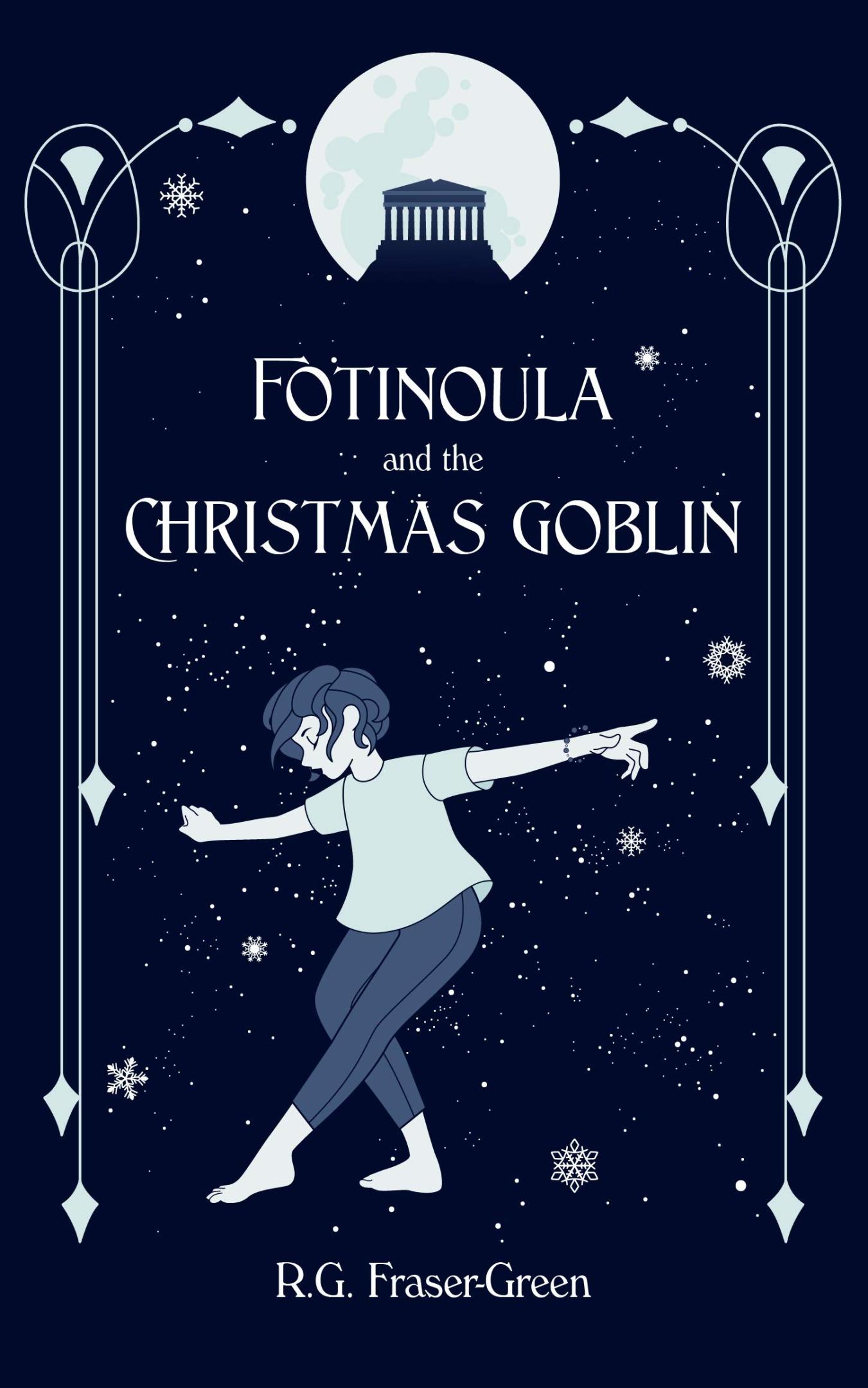
I was kindly sent a review copy of this book by the author for which my thanks.
A children’s story with a Christmas setting, with its young heroine having to battle a sinister creature to protect those she loves, Fotinoula and the Christmas Goblin (2020) by R. G. Fraser Green made for an enjoyable read and stood out to me most for elements of Greek culture and observances, folklore, and a fair few delicacies, mostly sweet!
Foutinoula (her name is Fotini or light, ‘oula’ being a term of endearment suffixed to girls’ names; thus, her little sister Mirto or myrtle becomes ‘Mirtoula’) is an eleven-year-old girl who lives in Athens with her mother and four-year-old sister, while her father, a sailor is away at sea often. He does however, always stay for Christmas but unfortunately this year, he is on duty—but before leaving he hands over his lucky bronze Athena figure to Fotinoula asking her to keep an especial eye on Mirtoula. Fotinoula can’t understand why this may be though she notes that while her Baba loved both his daughters the same, he seemed to take extra care of Mirtoula during the Christmas holiday. Some clue to this mystery and her task is revealed by her Grandfather, who tells her about the ‘Christmas’ goblins, the Kallikantzaroi, who appear during the twelve days of Christmas, generally making mischief and worse but who are a particular danger to young children born during this time. Adults might laugh these stories off as no more than legend or folklore, but they are very real indeed and as she soon discovers, can steal away little Mirtoula with terrifying consequences.
Armed with mostly her wits, and a notebook that her grandfather has left for her to read, Foutinoula must discover, first whether there is any truth to these stories at all, and if so, how she, all on her own, can not only face up to the rather frightening Kallikantzoi (for it is when she first encounters one that she realises how truly petrifying they can be) but also protect her sister!
While this is in many ways, a typical children’s adventure story—with an eleven-year-old protagonist (I still have to solve this puzzle of why they’re often eleven) and a magical/evil force to face up to, which challenges them in many ways—it is a thoroughly enjoyable read with just the right balance of warm and festive and unsettling and sinister to make for a perfect Christmas read (after all, we need something scary around the time, too). Fotinoula is a very likeable young girl, seemingly ordinary but one whose courage, resourcefulness, and wit shine through when she encounters the Kallikantzaroi. And on this adventure, it is not only the sinister goblins that pose a challenge, but also some of the usual problems or irritants of that age: not wanting your younger sibling tagging along all the time, or to visit (even if for a short while) one’s elderly neighbour. But Fotinoula soon realises that these things may not be quite as ‘bad’ as they seem but require just a little openminded (and hearted)-ness and understanding! Having spoken of the heroine, how can one not speak of the villains of the piece—those Kallikantzoi are indeed terrifying and quite good at manipulation, but their most frightening feature to me was being able to access one’s thoughts—creepy indeed. But that said, I loved how Fotinoula goes about battling them and some of the ideas she uses beyond what she is told.
As I already mentioned, my favourite aspect of the book was the elements of culture and observances woven into the story be it the New Year’s Day rituals of entering one’s house at midnight and turning on the lights, shattering a pomegranate for luck, and cutting into the Vasilopita—a basil cake (which also has a hidden coin that brings luck to the one who gets the piece with it)—or name-day celebrations. There was also a subtler mention of the previous conflict in Asia minor and the pain, displacement, and separation that resulted for the common people on both sides as well the syncretic Greek Rebetiko music, which served both as a reminder of the home that was and as a source of strength. Another interesting facet of culture for me was how (as is the case in many other parts of the world; here I was reminded of Zen Cho’s Black Water Sister) Fotinoula relies on both the ancient gods (here Athena) as well as the church for strength (and practical action) during her ordeal.
I can’t close this review without a mention of the several mouth-watering eats that appear in the book from the Vasilopita to Kourabiethes (buttery shortbread biscuits with almonds) to diples (crisp fried pastry rolls in honey syrup) and more (there’s a helpful list/pronunciation guide for character and food names at the start with meanings explained as well). While these were all new to me, they did remind me of my first introduction to Greece and Greek sweets as a child reading the Bobbsey Twins’ Greek Hat Mystery, bringing back many fond memories.
A wonderful read for its intended audience (and older readers who still love their children’s books from time to time), at Christmas but also otherwise!
(Fota Press, 2020; pp. 180)








